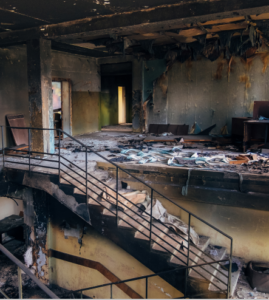
Simon Brand, Editor, F&RM
We have all seen them. In villages, towns, and cities across the country, empty and derelict buildings sit unused.
Often in a poor state of repair, many of them have been sat idle for months if not years, but these buildings are more than just unsightly eyesores. They represent a real target for arson, and that brings with it the fire threat to other nearby buildings, danger for the firefighters sent to deal with incidents, and large associated financial costs to building owners and insurers.
Costs and prevalence
Home Office figures for the year up to March 2022 show that fire and rescue services were called out to over 69,000 cases of arson, amounting to 45% of all fires attended. Whilst the majority of these relate to relatively small outdoor fires that pose little threat to people or property, there are still a large number of cases where homes, vehicles, and non-residential buildings are the target.
The Trends in Crime Survey for England and Wales (CSEW) details how there has been a twelve-month 23% increase in arson cases reported to police as a crime, up to 28,785 in the year ending September 2022, from 23,463 in the previous year.
Whilst the impact of lockdowns in 2021 will have depressed the number of cases in the earlier period, these stark figures show that, not only is arson the leading single cause of fire, but highlight the extent to which the increasing threat of arson must be taken seriously. The extent to which vacant properties are a part of the arson problem was highlighted in a report produced by Aviva in 2017.
“Commercial properties dominated the number of vacant business buildings”
It noted that approximately 9,000 fires in empty buildings occurred across the UK each year, and that 25% of their direct damage costs incurred related to unoccupied buildings. Behind these annual figures lies a huge financial impact. For the year 2017-18, the National Fire Chiefs Council estimated the potential economic cost attributed to arson to be between £5.5bn and £11bn.
With the threat of arson that vacant and unoccupied buildings pose, the fact that the number of these unused properties is growing year-on-year means the potential for incidents causing damage, costs, and threats to life is also growing.
Statistics published in 2019 by the then Ministry of Housing, Communities, and Local Government (now DLUHC) put the number of empty properties in the UK at 617,527. Business premises accounted for 172,217 of this total, and residential dwellings for 445,310 – with 225,845 of the residential buildings recorded as being empty for longer than six months.
Commercial properties dominated the number of vacant business buildings, making up more than a quarter of the overall number. Whilst these tended to be in larger urban areas – with Bradford, for example, accounting for 4.5% of all empty commercial properties in the UK – research from the Local Government Association showed that 80% of English councils reported an increase in empty commercial properties in their town centres in the year up to 2019.
Recent analysis of the government’s official data for 2022 by Action on Empty Homes also noted that long-term empty residential homes were at their highest level in over ten years.
Further reading: RAAC: How big of an issue is it?
Prime targets
 So why are vacant buildings so often linked to arson?
So why are vacant buildings so often linked to arson?
There are a number of factors that can lead to an unoccupied building being at higher risk of an arson attack, and when it is, for that fire to be more severe. When a building is left unattended, the opportunity for low level vandalism is increased, as there can be a perceived lack of surveillance. It has been shown that if small acts of damage, such as smashed windows or graffiti, are left unrepaired it can lead to an escalation of further similar acts – one broken window leads to another and then another.
This lack of care and maintenance can signpost an idle building as a potential arson target. In a similar way to the criminal damage, smaller fires are often initially set, and if little is done to prevent them, it paves the way for a larger scale incident. Even where vandalism does not occur, insufficient maintenance of a building left unused for a long period of time will see the building fabric deteriorate, leading to the failure of existing compartmentation.
If an arson attack does then occur, smoke and fire will be able to penetrate the building and spread more readily. This situation can be exacerbated by unauthorised and illegal use which can lead to accidental or deliberate damage, such as ‘urban mining’ where fixtures and fittings are stripped leaving gaps through which fire can spread, or a build-up of combustible waste materials.
Vacant buildings, by their nature, have little to no human presence and so if an arson attack does occur, there is unlikely to be anyone present to discover the fire and raise the alarm.
Without this early intervention, arson fires are therefore more likely to be able to grow into large incidents, resulting in more danger to the locality and more damage to the building. It is important for building owners to note that, even though a building may be empty or unused, the responsibility for fire safety remains with them and the same legal obligations as when the building was in use still apply.
It is therefore paramount that owners keep up the fire security of their buildings throughout its lifecycle, especially given the problems that unoccupied premises can face.
Ensuring risk assessments are conducted as a building’s use comes to an end and then throughout any period of vacancy is an essential action for owners. Simply abandoning a building will quickly lead to issues and potential arson attacks, so this must be avoided.
Security and safety
There are a number of key actions that a building owner can take to mitigate the risk of an arson attack, starting with designating responsibility for the building to an individual or managing agent. Restricting access to the site of an unoccupied building is a key factor in preventing arson attacks. Depending on the type of site it may require that both the perimeter of the site as well as the buildings themselves be physically secured.
 Where there is a perimeter, such as with industrial/ commercial properties or buildings under construction, these should be secured using perimeter fencing at least 2m in height. Where existing perimeter structures are in place, these should be assessed for possible anti-intrusion upgrades, such as anti-climb paint or barbed tape.
Where there is a perimeter, such as with industrial/ commercial properties or buildings under construction, these should be secured using perimeter fencing at least 2m in height. Where existing perimeter structures are in place, these should be assessed for possible anti-intrusion upgrades, such as anti-climb paint or barbed tape.
Obvious aids to climbing should be removed or secured and access to low roofs should be deterred to prevent intruders. Whether there is a separate perimeter or not, any arson risk assessment should consider site access points, with the number being kept to the fewest possible needed.
External doors and windows should be fitted with working locks or otherwise secured with shutters, grilles, or bars particularly on the ground floor. One aspect of a building that can give an easy point of entry for an arson attack is a letterbox, and these should be sealed and post redirected. This will also prevent a build-up of unopened mail, a potential source of combustible material.
“Ensuring that a vacant building is well-maintained not only provides less opportunity for arson attacks to take hold and cause serious damage, it also reduces the likelihood of an attack in the first place.”
 Where appropriate, the boarding up of entry points can take place, giving a more robust deterrent to possible intruders. External lighting, CCTV, and other forms of intruder detection can also be installed to help a vacant site be less of a target to potential fire raising. These can take the form of remotely monitored security systems or staffed guarding stations and patrols.
Where appropriate, the boarding up of entry points can take place, giving a more robust deterrent to possible intruders. External lighting, CCTV, and other forms of intruder detection can also be installed to help a vacant site be less of a target to potential fire raising. These can take the form of remotely monitored security systems or staffed guarding stations and patrols.
The installation and maintenance of fire safety features is vital in helping mitigate any potential arson attacks, and reducing the extent of any blaze and the damage done should one occur. Where possible it is recommended that vacant buildings have comprehensive automatic fire and smoke detectors, linked to a monitoring service.
It is important that fire protection equipment remains serviceable and access to water for fire fighters must remain clear. The building heat should be kept on during cold months, or if this is not practical the sprinkler system can be converted into a dry pipe system after consultation with the building insurers. Insurers will also likely expect that the integrity of fire alarms and systems continues to be inspected, tested, and maintained in line with the relevant British Standards.
Ensuring that a vacant building is well-maintained not only provides less opportunity for arson attacks to take hold and cause serious damage, it also reduces the likelihood of an attack in the first place.
It is buildings with no obvious owners that are often the initial targets of the vandalism that can lead to a future arson. When a building is vacated, all combustible waste and hazardous materials should be disposed of, thus reducing potential fuel sources, and regular visits should be made to the site to check and remove any rubbish that may have been dumped. Effective features restricting access to the site will also help prevent fly tipping.
These regular checks should also assess the state of external fixtures and fittings, as these can provide fire raisers with combustible materials, for example, broken fence panels or disused wooden sheds and outbuildings. If necessary, foliage and plants should also be maintained or removed to give the appearance of a well-maintained site, to allow effective security monitoring, to prevent access to roofs, and to remove potential combustibles.
Insurance and firefighting
 A building owner should be in discussion with their insurer ahead of the occupancy ending as they will expect the building to still be managed. Indeed, some insurance cover will mandate that regular inspections of vacant buildings takes place to check for damage. Where damage has occurred, it should be reported to the insurers and fixed as soon as possible.
A building owner should be in discussion with their insurer ahead of the occupancy ending as they will expect the building to still be managed. Indeed, some insurance cover will mandate that regular inspections of vacant buildings takes place to check for damage. Where damage has occurred, it should be reported to the insurers and fixed as soon as possible.
This will help prevent further issues arising, signalling the site as a potential target for arson. It is important to remember that where empty premises are left with inadequate security and fire safety measures, insurance claims for any arson attacks may be denied.
“Missing fixtures and fittings can lead to greater and swifter fire spread”
Combating arson fires in a vacant building can also be more challenging for firefighters if the building has been allowed to deteriorate. Missing fixtures and fittings can lead to greater and swifter fire spread, and the structure of the building may also have been damaged, increasing the risk of building collapse or falls by attending firefighters.
Indeed, according to the US National Fire Protection Agency, fires in vacant and abandoned buildings tend to injure firefighters more often than other fires. Maintaining a secure empty property is vital to not only prevent arson attacks, but to allow for safer firefighting conditions.
Building owners should be aware that they retain the legal obligations for the safety of anyone on the site, whether authorised or not. Should injury or death occur as a result of an arson incident, such as detailed above, the owner could be investigated and prosecuted. It is therefore paramount that buildings that are left idle should be properly managed, secured, and protected from the threat of arson attacks.
This article first appeared in the March 2023 issue of the Fire Protection Association journal, Fire & Risk Management.


 So why are vacant buildings so often linked to arson?
So why are vacant buildings so often linked to arson? Where there is a perimeter, such as with industrial/ commercial properties or buildings under construction, these should be secured using perimeter fencing at least 2m in height. Where existing perimeter structures are in place, these should be assessed for possible anti-intrusion upgrades, such as anti-climb paint or barbed tape.
Where there is a perimeter, such as with industrial/ commercial properties or buildings under construction, these should be secured using perimeter fencing at least 2m in height. Where existing perimeter structures are in place, these should be assessed for possible anti-intrusion upgrades, such as anti-climb paint or barbed tape. Where appropriate, the boarding up of entry points can take place, giving a more robust deterrent to possible intruders. External lighting, CCTV, and other forms of intruder detection can also be installed to help a vacant site be less of a target to potential fire raising. These can take the form of remotely monitored security systems or staffed guarding stations and patrols.
Where appropriate, the boarding up of entry points can take place, giving a more robust deterrent to possible intruders. External lighting, CCTV, and other forms of intruder detection can also be installed to help a vacant site be less of a target to potential fire raising. These can take the form of remotely monitored security systems or staffed guarding stations and patrols. A building owner should be in discussion with their insurer ahead of the occupancy ending as they will expect the building to still be managed. Indeed, some insurance cover will mandate that regular inspections of vacant buildings takes place to check for damage. Where damage has occurred, it should be reported to the insurers and fixed as soon as possible.
A building owner should be in discussion with their insurer ahead of the occupancy ending as they will expect the building to still be managed. Indeed, some insurance cover will mandate that regular inspections of vacant buildings takes place to check for damage. Where damage has occurred, it should be reported to the insurers and fixed as soon as possible.